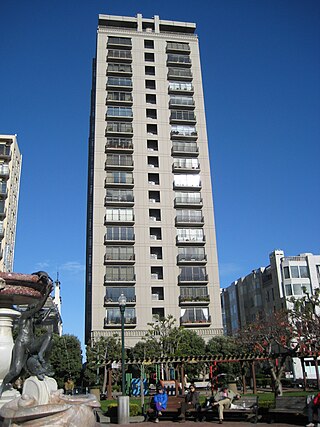Property law is the area of law that governs the various forms of ownership in real property (land) and personal property. Property refers to legally protected claims to resources, such as land and personal property, including intellectual property. Property can be exchanged through contract law, and if property is violated, one could sue under tort law to protect it.
In property law, title is an intangible construct representing a bundle of rights in (to) a piece of property in which a party may own either a legal interest or equitable interest. The rights in the bundle may be separated and held by different parties. It may also refer to a formal document, such as a deed, that serves as evidence of ownership. Conveyance of the document may be required in order to transfer ownership in the property to another person. Title is distinct from possession, a right that often accompanies ownership but is not necessarily sufficient to prove it. In many cases, possession and title may each be transferred independently of the other. For real property, land registration and recording provide public notice of ownership information.
In English law, a fee simple or fee simple absolute is an estate in land, a form of freehold ownership. A "fee" is a vested, inheritable, present possessory interest in land. A "fee simple" is real property held without limit of time under common law, whereas the highest possible form of ownership is a "fee simple absolute", which is without limitations on the land's use.
In common law and statutory law, a life estate is the ownership of immovable property for the duration of a person's life. In legal terms, it is an estate in real property that ends at death, when the property rights may revert to the original owner or to another person. The owner of a life estate is called a "life tenant". The person who will take over the rights upon death is said to have a "remainder" interest and is known as a "remainderman".
This aims to be a complete list of the articles on real estate.

A lease is a contractual arrangement calling for the user to pay the owner for the use of an asset. Property, buildings and vehicles are common assets that are leased. Industrial or business equipment are also leased. Basically a lease agreement is a contract between two parties: the lessor and the lessee. The lessor is the legal owner of the asset, while the lessee obtains the right to use the asset in return for regular rental payments. The lessee also agrees to abide by various conditions regarding their use of the property or equipment. For example, a person leasing a car may agree to the condition that the car will only be used for personal use.
A leasehold estate is an ownership of a temporary right to hold land or property in which a lessee or a tenant has rights of real property by some form of title from a lessor or landlord. Although a tenant does hold rights to real property, a leasehold estate is typically considered personal property.
The four unities is a concept in the common law of real property that describes conditions that must exist in order to create certain kinds of property interests. Specifically, these four unities must be met for two or more people to own property as joint tenants with legal right of survivorship, or for a married couple to own property as tenants by the entirety. Some jurisdictions may require additional unities.
A profit, in the law of real property, is a nonpossessory interest in land similar to the better-known easement, which gives the holder the right to take natural resources such as petroleum, minerals, timber, and wild game from the land of another. Indeed, because of the necessity of allowing access to the land so that resources may be gathered, every profit contains an implied easement for the owner of the profit to enter the other party's land for the purpose of collecting the resources permitted by the profit.
A covenant, in its most general sense and historical sense, is a solemn promise to engage in or refrain from a specified action. Under historical English common law, a covenant was distinguished from an ordinary contract by the presence of a seal. Because the presence of a seal indicated an unusual solemnity in the promises made in a covenant, the common law would enforce a covenant even in the absence of consideration. In United States contract law, an implied covenant of good faith is presumed.
A servitude is a qualified beneficial interest severed or fragmented from the ownership of an inferior property and attached to a superior property or to some person other than the owner. At civil law, ownership (dominium) is the only full real right whereas a servitude is a subordinate real right on par with wayleaves, real burdens, security interests, and reservations. There are two types: predial, attaching to property, and personal, attaching to a person.
In property law and real estate, a future interest is a legal right to property ownership that does not include the right to present possession or enjoyment of the property. Future interests are created on the formation of a defeasible estate; that is, an estate with a condition or event triggering transfer of possessory ownership. A common example is the landlord-tenant relationship. The landlord may own a house, but has no general right to enter it while it is being rented. The conditions triggering the transfer of possession, first to the tenant then back to the landlord, are usually detailed in a lease.

The Law of Property Act 1925 is a statute of the United Kingdom Parliament. It forms part of an interrelated programme of legislation introduced by Lord Chancellor Lord Birkenhead between 1922 and 1925. The programme was intended to modernise the English law of real property. The Act deals principally with the transfer of freehold or leasehold land by deed.

A freehold, in common law jurisdictions such as England and Wales, Australia, Canada, Ireland, and twenty states in the United States, is the common mode of ownership of real property, or land, and all immovable structures attached to such land.
An easement is a nonpossessory right to use and/or enter onto the real property of another without possessing it. It is "best typified in the right of way which one landowner, A, may enjoy over the land of another, B". An easement is a property right and type of incorporeal property in itself at common law in most jurisdictions.

Landlord–tenant law is the field of law that deals with the rights and duties of landlords and tenants.
Easements in English law are certain rights in English land law that a person has over another's land. Rights recognised as easements range from very widespread forms of rights of way, most rights to use service conduits such as telecommunications cables, power supply lines, supply pipes and drains, rights to use communal gardens and rights of light to more strained and novel forms. All types are subject to general rules and constraints. As one of the formalities in English law express, express legal easements must be created by deed.

English land law is the law of real property in England and Wales. Because of its heavy historical and social significance, land is usually seen as the most important part of English property law. Ownership of land has its roots in the feudal system established by William the Conqueror after 1066, but is now mostly registered and sold on the real estate market. The modern law's sources derive from the old courts of common law and equity, and legislation such as the Law of Property Act 1925, the Settled Land Act 1925, the Land Charges Act 1972, the Trusts of Land and Appointment of Trustees Act 1996 and the Land Registration Act 2002. At its core, English land law involves the acquisition, content and priority of rights and obligations among people with interests in land. Having a property right in land, as opposed to a contractual or some other personal right, matters because it creates priority over other people's claims, particularly if the land is sold on, the possessor goes insolvent, or when claiming various remedies, like specific performance, in court.

In English common law, real property, real estate, immovable property or, solely in the US and Canada, realty, refers to parcels of land and any associated structures which are the property of a person. In order for a structure to be considered part of the real property, it must be integrated with or affixed to the land. This includes crops, buildings, machinery, wells, dams, ponds, mines, canals, and roads. The term is historic, arising from the now-discontinued form of action, which distinguished between real property disputes and personal property disputes. Personal property, or personalty, was, and continues to be, all property that is not real property.
Property lawin the United States is the area of law that governs the various forms of ownership in real property and personal property, including intangible property such as intellectual property. Property refers to legally protected claims to resources, such as land and personal property. Property can be exchanged through contract law, and if property is violated, one could sue under tort law to protect it.






